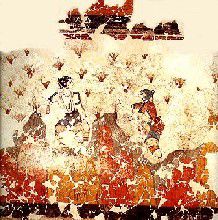The wall-paintings from Akrotiri, Thera

|
 |
The wall-paintings from Akrotiri, Thera, are distinguished by the
originality of their iconography, the freedom in the design and rendering of the
figures, and the richness of their colours. Their perfect state of preservation,
thanks to their burial in volcanic ash, has allowed the identification of
several different artists working within a Theran tradition but under strong
Cretan influence. The painter of the 'Boxing children' and of the 'Antelopes'
displays a characteristic simplicity and austerity which are balanced with grace
and vitality in the design of the figures. The painter of the 'Spring' fresco
and of the 'Crocus gatherers' is distinguished by the freedom and spontaneity of
his compositions, a greater attention to naturalism and detail, an almost
photographic rendering of fleeting moments and a profuse use of colour.
|
|
The stone-built walls were covered first with clay mixed with
straw, then with a thick layer of plaster and lastly with successive thin
plaster layers. The painter sketched the preliminary design on the wet surface
using twine and a pointed tool. The paint was also applied on a wet surface,
which led to its good preservation, although some details were added after the
plaster had dried. The colours were either mineral (iron for dark red) or yellow
ochre, or synthetic (pyrite with copper and Iime oxides for light blue).


| |
|
|
|
|



